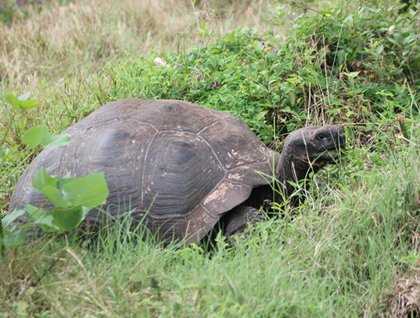This morning when we awoke we found we were anchored in a busy harbor off Santa Cruz Island called Academy Bay. This is the entry way to the town of Puerto Ayora. The bay is named after the California Academy of Sciences which sponsored a major expedition to Galápagos in 1905-06 and the town is named after an early Ecuadorian president. Puerto Ayora is home for over 20,000 inhabitants who work in support of the booming tourism industry and for the National Park and Charles Darwin Research Station. The headquarters of both these institutions can be found to the east of the town. After a hearty breakfast we boarded the Zodiacs for a short ride to shore and a visit to the tortoise breeding facilities - a joint project of the SPNG and CDRS mentioned above.
Naturalists Aura, Celso and Jeffo led us along a boardwalk and through the visitor’s center where we learned that the captive tortoise breeding program has been most successful in restoration of several of the endangered giant tortoises. In particular, a male tortoise affectionately known as “Super Diego” for his excellent reproductive capacities has quite a story behind him. He was taken from the Galápagos and sent to the San Diego Zoo in the early 1900’s and then returned to the islands several decades later when the scientists realized that the Española tortoise population was in grave danger of extinction. From a tiny remnant adult population of 15 animals, which were brought from the wild to the breeding center on Santa Cruz, and of which only three were males (including Super Diego) we now have over 2,000 wild tortoises once again roaming the southeastern island of Española!
We enjoyed seeing and photographing the small hatchling tortoises, protected in captivity until they are repatriated to the islands of their origin, as well as adults from several of the different island populations. We then also enjoyed a walk through town, the chance to shop at numerous colorful boutiques and small tiendas and the lively scene at the fish market. We gathered at a café – The Rock – for a glass of fruit juice and here boarded buses which took us to El Trapiche – a sugar cane and coffee plantation. We saw and learned how sugar cane and coffee are produced and processed and enjoyed tasting samples of each.
We ate a delicious buffet lunch at the farm, El Chato, and then several of us took turns crawling into an empty tortoise shell to have our pictures taken. We boarded the buses again and drove to a lower section of the farm where we went in search of giant tortoises in the lush green vegetation. We found a couple of huge males and several more of these endemic reptiles hidden in the grass and soaking in a rainwater-filled pond. Everyone had great photo opportunities of the giant tortoises although some biting introduced ants made us move along and kept up from dallying in any one spot for too long.
We entered a “double decker” lava tunnel and learned that these volcanic structures, formed when lava flows cool on the surface and then empty out, are found all across the highlands of these islands. The buses took us back down to the coast and some of us returned to the ship to shower and rest while others did a bit more shopping or explored the town until the last panga took us back on board at 1800. Tonight we watched Patrick’s video preview and after dinner were entertained by the local musicians and dancers of the folkloric group EcoArte. The full moon was high in the sky by the time our Captain Teran had his crew haul up the anchor of the National Geographic Islander at 2230 and we set course for San Cristobal Island to the east.







